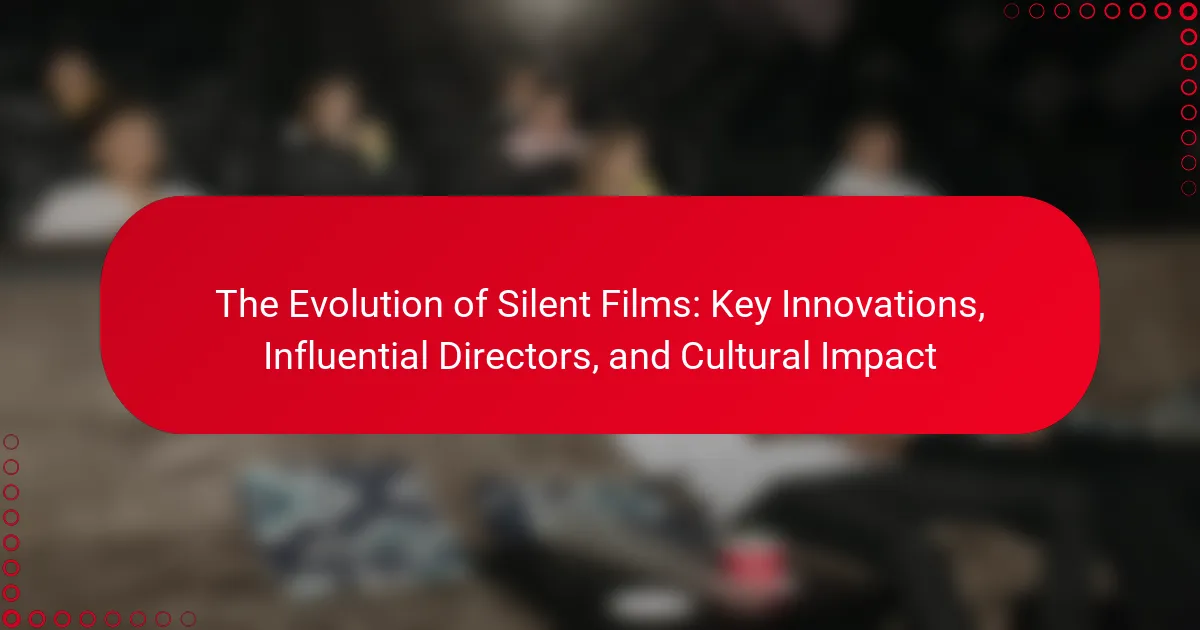Silent films are motion pictures that rely on visual storytelling without synchronized sound, emerging in the late 19th century. Key innovations such as the motion picture camera, intertitles, and film editing techniques transformed cinema, allowing filmmakers to convey narratives effectively. Influential directors like D.W. Griffith, Charlie Chaplin, and Fritz Lang played significant roles in shaping the genre, contributing to its artistic and cultural impact. The silent film era not only established cinema as a popular entertainment medium but also addressed social themes, influencing public perceptions and cultural expression. The transition to sound films marked the decline of silent cinema, yet its legacy continues to resonate in modern filmmaking.

What are Silent Films and How Did They Evolve?
Silent films are motion pictures without synchronized sound, primarily relying on visual storytelling. They emerged in the late 19th century, with notable examples like “The Great Train Robbery” in 1903. Early silent films used intertitles to convey dialogue and context. The lack of sound led to creative visual techniques, such as exaggerated gestures and expressive acting.
The evolution of silent films was marked by technological advancements. The introduction of the motion picture camera and film stock improved image quality. By the 1920s, silent films had reached their peak, with directors like Charlie Chaplin and D.W. Griffith innovating cinematic techniques.
The transition to sound films began in the late 1920s, culminating in the release of “The Jazz Singer” in 1927. This film featured synchronized dialogue and music, signaling the decline of silent films. Despite this, silent films remain a significant part of cinematic history, influencing future filmmakers and storytelling methods.
What defines a silent film?
A silent film is defined as a motion picture that does not include synchronized recorded sound, particularly spoken dialogue. These films typically rely on visual storytelling, using expressive acting and intertitles to convey the narrative. Silent films were prevalent from the late 19th century until the late 1920s. The absence of sound necessitated innovative techniques in cinematography and editing. Iconic silent films include “The Birth of a Nation” and “City Lights.” The transition to sound films began with “The Jazz Singer” in 1927, marking the end of the silent film era. Silent films remain significant for their artistic contributions and historical context in film evolution.
What are the key characteristics of silent films?
Silent films are characterized by the absence of synchronized sound, relying on visual storytelling. They use exaggerated gestures and [censured] expressions to convey emotions. Title cards are utilized to provide dialogue and context. The cinematography often emphasizes visual composition and lighting effects. Music played a crucial role, typically performed live during screenings. Editing techniques were innovative, including cross-cutting and close-ups. The genre often included melodrama, comedy, and adventure themes. Silent films laid the groundwork for future cinematic techniques and storytelling methods.
How do silent films differ from sound films?
Silent films lack synchronized sound and dialogue, while sound films incorporate audio elements. Silent films rely on visual storytelling, using gestures, [censured] expressions, and intertitles to convey meaning. In contrast, sound films utilize spoken dialogue, sound effects, and music to enhance the narrative. The transition to sound began with “The Jazz Singer” in 1927, marking a significant shift in filmmaking. This innovation changed audience engagement and storytelling techniques. Silent films often featured exaggerated acting styles, while sound films allowed for more nuanced performances. The introduction of sound also led to advancements in technology and film production methods.
What historical context led to the rise of silent films?
The rise of silent films was influenced by technological advancements and cultural shifts in the early 20th century. The invention of motion picture cameras in the late 1890s allowed filmmakers to capture moving images. Early films were short and lacked synchronized sound. The audience’s fascination with visual storytelling drove demand for longer narratives. The absence of sound also made films more accessible across language barriers. Additionally, the growth of urban centers created a larger audience for entertainment. The establishment of nickelodeons in the early 1900s provided affordable access to films. These factors combined to create a fertile environment for the silent film industry to flourish.
How did technological advancements influence silent film production?
Technological advancements significantly influenced silent film production by enhancing visual storytelling and production efficiency. Innovations like the introduction of electric lights allowed for better illumination of scenes. This improved clarity and detail in cinematography. The development of the portable camera enabled filmmakers to shoot on location, adding realism to narratives. Advances in film stock also contributed to higher quality images. The use of intertitles for dialogue and exposition became standardized, facilitating storytelling without sound. Editing techniques evolved with the invention of the editing machine, allowing for more complex narratives. Sound synchronization technology, although not fully realized until later, began to emerge, influencing the transition to sound films. These advancements collectively transformed silent films into a more dynamic and engaging medium.
What role did societal factors play in the popularity of silent films?
Societal factors significantly influenced the popularity of silent films. The early 20th century saw a rise in urbanization and industrialization. These changes led to more people having leisure time and disposable income. Silent films became a primary form of entertainment during this period. They appealed to a diverse audience, transcending language barriers. The lack of synchronized sound made them accessible to non-English speakers. Additionally, societal norms and values were reflected in the storytelling of silent films. Themes of romance, adventure, and comedy resonated with audiences. The cultural context of the time also fostered a fascination with visual storytelling. This combination of factors contributed to the widespread popularity of silent films.

What Key Innovations Shaped Silent Films?
The key innovations that shaped silent films include the introduction of the motion picture camera, the use of intertitles, and the development of film editing techniques. The motion picture camera allowed filmmakers to capture moving images, which was a revolutionary advancement in visual storytelling. Intertitles provided essential dialogue and narrative context, bridging gaps in the silent format. Film editing techniques, such as cross-cutting and montage, enhanced storytelling by manipulating time and space within the narrative. These innovations collectively transformed cinema into a compelling art form. The first successful motion picture camera was developed by Louis Le Prince in the 1880s. The use of intertitles became prominent in films like D.W. Griffith’s “The Birth of a Nation” in 1915. Editing techniques were further refined by pioneers like Sergei Eisenstein, who introduced montage in films such as “Battleship Potemkin” in 1925.
What technological advancements were pivotal in silent film development?
The technological advancements pivotal in silent film development include the invention of the motion picture camera and the introduction of film editing techniques. The motion picture camera allowed filmmakers to capture moving images, fundamentally changing storytelling. Early models, like the Kinetoscope, emerged in the late 19th century.
Film editing techniques, such as cross-cutting and continuity editing, enhanced narrative structure. These methods enabled filmmakers to create complex stories by juxtaposing different scenes. The development of celluloid film stock improved image quality and allowed for longer recordings.
The introduction of the projector made it possible to display films to larger audiences. Innovations in lighting and set design also contributed to the visual storytelling of silent films. Overall, these advancements collectively transformed filmmaking into a recognized art form.
How did the introduction of intertitles enhance storytelling in silent films?
The introduction of intertitles significantly enhanced storytelling in silent films. Intertitles provided essential dialogue and narrative context that silent visuals could not convey alone. They allowed filmmakers to express character thoughts, emotions, and plot developments directly to the audience. This innovation helped bridge the gap between visual storytelling and audience comprehension. Intertitles also facilitated pacing and timing, enabling smoother transitions between scenes. Historical examples, such as D.W. Griffith’s “The Birth of a Nation,” showcased the effective use of intertitles to advance the narrative. By integrating text, filmmakers could create more complex and engaging stories. Ultimately, intertitles transformed silent films into a more cohesive and emotionally resonant medium.
What impact did film editing techniques have on silent cinema?
Film editing techniques significantly enhanced storytelling in silent cinema. They allowed filmmakers to create a narrative structure that engaged audiences. Techniques such as cross-cutting enabled simultaneous action in different locations. This technique heightened suspense and emotional impact. Montage editing condensed time and space, allowing for more dynamic storytelling. It also facilitated the juxtaposition of images for thematic depth. Silent films like “The Birth of a Nation” (1915) showcased innovative editing to convey complex narratives. The impact of editing techniques helped establish cinema as a powerful art form.
How did sound and music contribute to the silent film experience?
Sound and music significantly enhanced the silent film experience by providing emotional depth and context. Silent films relied on live musical accompaniment to convey mood and tone. This practice helped audiences engage more deeply with the narrative. Music underscored dramatic moments and heightened tension during pivotal scenes. Additionally, sound effects were sometimes used to simulate actions, creating a more immersive environment. Historical records indicate that orchestras or pianists were common in theaters, adapting scores to fit the film. The integration of music transformed the viewing experience, making it more dynamic and memorable.
What types of musical accompaniment were commonly used in silent films?
Silent films commonly used live musical accompaniment. This included orchestras, small ensembles, and pianists. The music was meant to enhance the emotional impact of the film. Often, scores were improvised to match the on-screen action. Theaters would employ musicians to perform during screenings. Some films came with specific sheet music for guidance. The use of music varied based on the film’s genre and mood. Historical records indicate that this practice was essential for audience engagement.
How did live performances influence the viewing experience of silent films?
Live performances significantly enhanced the viewing experience of silent films. The presence of live music, sound effects, and live narration created an immersive atmosphere. Musicians would adapt their performances to match the film’s mood and action. This added emotional depth and engagement for the audience. Live narrators provided context and commentary, helping viewers understand the storyline. The combination of these elements made silent films more dynamic and entertaining. Historical accounts indicate that audiences often responded more emotionally during live performances. This interaction between performers and the audience fostered a communal viewing experience.

Who Were the Influential Directors in Silent Film History?
Influential directors in silent film history include D.W. Griffith, Charlie Chaplin, and Fritz Lang. D.W. Griffith is known for pioneering narrative techniques in films like “The Birth of a Nation” and “Intolerance.” His innovative use of close-ups and cross-cutting significantly shaped cinematic storytelling. Charlie Chaplin, through his character “The Tramp,” brought humor and pathos to silent films. His works, such as “City Lights” and “The Kid,” remain iconic for their emotional depth. Fritz Lang is recognized for his contributions to the science fiction genre with films like “Metropolis.” His visual style and thematic complexity influenced future filmmakers. These directors played crucial roles in establishing the foundations of modern cinema.
Which directors are considered pioneers of silent cinema?
D.W. Griffith, Charlie Chaplin, and F.W. Murnau are considered pioneers of silent cinema. D.W. Griffith is known for his innovative narrative techniques and the film “The Birth of a Nation” (1915). Charlie Chaplin brought character-driven storytelling to life with iconic films like “The Kid” (1921). F.W. Murnau is celebrated for his visual storytelling in “Nosferatu” (1922). These directors significantly shaped the art of filmmaking during the silent era. Their contributions laid the groundwork for future cinematic techniques and storytelling methods.
What unique styles did directors like D.W. Griffith and Charlie Chaplin bring to silent films?
D.W. Griffith and Charlie Chaplin introduced distinctive styles that shaped silent films. Griffith is known for pioneering narrative techniques and innovative editing. He utilized cross-cutting to build suspense and develop parallel storylines. His film “The Birth of a Nation” showcased these methods, making it a landmark in cinematic history.
In contrast, Chaplin focused on physical comedy and character-driven storytelling. His iconic character, the Tramp, exemplified a blend of humor and pathos. Chaplin’s use of expressive body language conveyed emotions without dialogue. His film “City Lights” is a prime example of this unique style, combining comedy with a poignant narrative.
Both directors left an indelible mark on the silent film era, influencing future filmmakers with their innovative approaches.
How did these directors influence the narrative techniques in silent films?
Directors such as D.W. Griffith and Sergei Eisenstein significantly influenced narrative techniques in silent films. D.W. Griffith introduced innovative editing techniques, including cross-cutting and flashbacks. These methods enhanced storytelling by allowing simultaneous action to unfold. Griffith’s film “The Birth of a Nation” showcased these techniques, impacting future filmmakers. Sergei Eisenstein emphasized montage, creating emotional resonance through juxtaposition. His work in “Battleship Potemkin” demonstrated how editing could convey complex narratives. Both directors set foundational principles that shaped silent film storytelling. Their contributions established a framework for visual narrative that persists in cinema today.
What contributions did international directors make to silent films?
International directors significantly shaped silent films through innovative storytelling techniques and visual styles. Directors like F.W. Murnau from Germany introduced groundbreaking cinematography in films like “Nosferatu.” Their use of expressionist elements influenced the emotional depth of storytelling. Italian directors, such as Giovanni Pastrone, contributed epic narratives with films like “Cabiria,” showcasing elaborate set designs and action sequences. Russian directors, including Sergei Eisenstein, pioneered montage editing, enhancing narrative pacing and emotional impact. These contributions collectively enriched the silent film medium, establishing a foundation for future cinematic techniques.
How did filmmakers from different countries approach silent cinema differently?
Filmmakers from different countries approached silent cinema with distinct styles and techniques. American filmmakers emphasized narrative clarity and spectacle, often using innovative editing techniques. For example, D.W. Griffith’s “The Birth of a Nation” showcased advanced storytelling methods and large-scale productions. In contrast, French filmmakers like Georges Méliès focused on fantasy and special effects, creating imaginative narratives through elaborate sets and trick photography. German filmmakers, particularly during the Weimar Republic, adopted expressionist techniques, emphasizing mood and visual style, as seen in “The Cabinet of Dr. Caligari.” Soviet filmmakers, such as Sergei Eisenstein, utilized montage to convey political messages and emotional impact, exemplified in “Battleship Potemkin.” Each country’s approach reflected its cultural context and artistic priorities, shaping the evolution of silent cinema.
What are some notable international silent films and their directors?
Notable international silent films include “The Birth of a Nation” directed by D.W. Griffith. “Nosferatu,” directed by F.W. Murnau, is another significant film. “The Cabinet of Dr. Caligari,” directed by Robert Wiene, is also essential in silent film history. “The Passion of Joan of Arc,” directed by Carl Theodor Dreyer, is highly acclaimed. “Metropolis,” directed by Fritz Lang, is a landmark in science fiction cinema. “The General,” directed by Buster Keaton, showcases exceptional comedy. Each of these films played a crucial role in the development of cinematic techniques and storytelling.

What Was the Cultural Impact of Silent Films?
Silent films significantly shaped cultural expression and societal norms in the early 20th century. They introduced visual storytelling that transcended language barriers. This form of cinema influenced art, fashion, and music, as filmmakers began to experiment with visual aesthetics. Iconic stars like Charlie Chaplin and Buster Keaton became cultural symbols, impacting public perceptions of humor and social issues. Silent films also highlighted social themes, such as class struggles and gender roles, prompting discussions in society. The era saw the rise of film as a popular entertainment medium, leading to the establishment of cinema as a communal experience. The transition to sound films marked the end of this era, but the cultural legacy of silent films continues to influence modern cinema.
How did silent films influence popular culture in their time?
Silent films significantly influenced popular culture by shaping entertainment and social norms. They introduced visual storytelling that captivated audiences worldwide. Iconic stars like Charlie Chaplin and Buster Keaton became cultural icons, influencing fashion and behavior. The films often addressed social issues, reflecting and shaping public sentiment. Silent film screenings became social events, fostering community engagement. The era also laid the groundwork for future cinematic techniques and genres. Innovations in cinematography and editing emerged during this time, enhancing storytelling. As a result, silent films left a lasting legacy on the film industry and popular culture.
What themes and social issues were commonly addressed in silent films?
Silent films commonly addressed themes of social class struggle, morality, and human emotion. They often depicted the challenges faced by the working class. Many narratives focused on poverty and the impact of industrialization. Romantic relationships were also a prevalent theme, highlighting love’s triumphs and trials. Social issues such as gender roles and women’s rights were explored, often portraying women in both traditional and progressive roles. The influence of war and its consequences was another common subject, reflecting societal fears and realities. Additionally, silent films tackled themes of justice and revenge, often leading to dramatic conclusions. These themes were significant in shaping public discourse during the silent film era.
How did silent films shape the public’s perception of cinema as an art form?
Silent films established cinema as a legitimate art form through visual storytelling and innovative techniques. They relied heavily on expressive acting, cinematography, and editing to convey emotions and narratives. This reliance on visuals allowed filmmakers to experiment with artistic styles. Directors like D.W. Griffith pioneered techniques such as close-ups and cross-cutting, enhancing emotional depth. The absence of synchronized sound pushed filmmakers to create compelling visual compositions. Audiences began to appreciate film as a medium for artistic expression rather than mere entertainment. Landmark films like “The Birth of a Nation” and “Metropolis” showcased the potential of cinema to convey complex themes. As a result, silent films played a crucial role in elevating the perception of cinema within the artistic community.
What legacy do silent films leave in modern filmmaking?
Silent films established foundational techniques that influence modern filmmaking. They pioneered visual storytelling through expressive acting and innovative cinematography. Directors like Charlie Chaplin and D.W. Griffith developed narrative structures still used today. Techniques such as close-ups and montage editing originated in the silent era. The use of intertitles to convey dialogue influenced modern screenwriting. Silent films also emphasized the importance of music in enhancing emotional impact. Their artistic styles inspired contemporary filmmakers in visual aesthetics. Overall, silent films left a lasting imprint on the language of cinema.
How do contemporary filmmakers draw inspiration from silent films?
Contemporary filmmakers draw inspiration from silent films through visual storytelling techniques. They often utilize expressive cinematography and mise-en-scène to convey emotions without dialogue. This approach emphasizes the importance of visuals in narrative construction. Filmmakers like Martin Scorsese and Aki Kaurismäki have cited silent films as significant influences on their work. Silent films often employed exaggerated gestures and [censured] expressions, which are now echoed in modern performances. The use of intertitles in silent films has inspired contemporary filmmakers to experiment with text and visuals. Additionally, the pacing and rhythm of silent films influence editing styles in current cinema. These elements demonstrate the lasting impact of silent films on modern filmmaking practices.
What lessons can be learned from the silent film era for today’s cinema?
The silent film era teaches today’s cinema the importance of visual storytelling. Filmmakers effectively conveyed emotions and narratives without dialogue. This reliance on visuals encourages creativity in cinematography and editing. It highlights the significance of body language and [censured] expressions in character development. The era also emphasizes the role of music in enhancing emotional impact. Live orchestras accompanied silent films, adding depth to the viewing experience. Furthermore, it showcases the value of pacing and timing in comedic and dramatic scenes. Filmmakers can learn to engage audiences through innovative techniques, drawing inspiration from the resourcefulness of silent film pioneers.
What are the best practices for appreciating silent films today?
To appreciate silent films today, viewers should focus on understanding the historical context and technical innovations of the era. Engaging with the film’s visual storytelling is essential, as silent films rely heavily on expressive acting and cinematography. Watching with a live musical accompaniment can enhance the emotional experience, as music played a critical role in silent film presentations.
Researching the directors and actors involved adds depth to the viewing experience. Familiarity with the cultural and social themes of the time can provide insight into the film’s message. Participating in discussions or attending screenings can foster a community appreciation. Lastly, utilizing resources such as film archives or documentaries can enrich understanding of the silent film legacy.
The main entity of the article is silent films, which are motion pictures characterized by the absence of synchronized sound and reliance on visual storytelling. The article explores the evolution of silent films, highlighting key innovations such as the motion picture camera, intertitles, and film editing techniques that shaped the medium. It discusses influential directors like D.W. Griffith and Charlie Chaplin, who pioneered narrative techniques and left a lasting impact on cinema. Additionally, the article examines the cultural significance of silent films, addressing their themes, societal reflections, and the legacy they have left on modern filmmaking practices.
